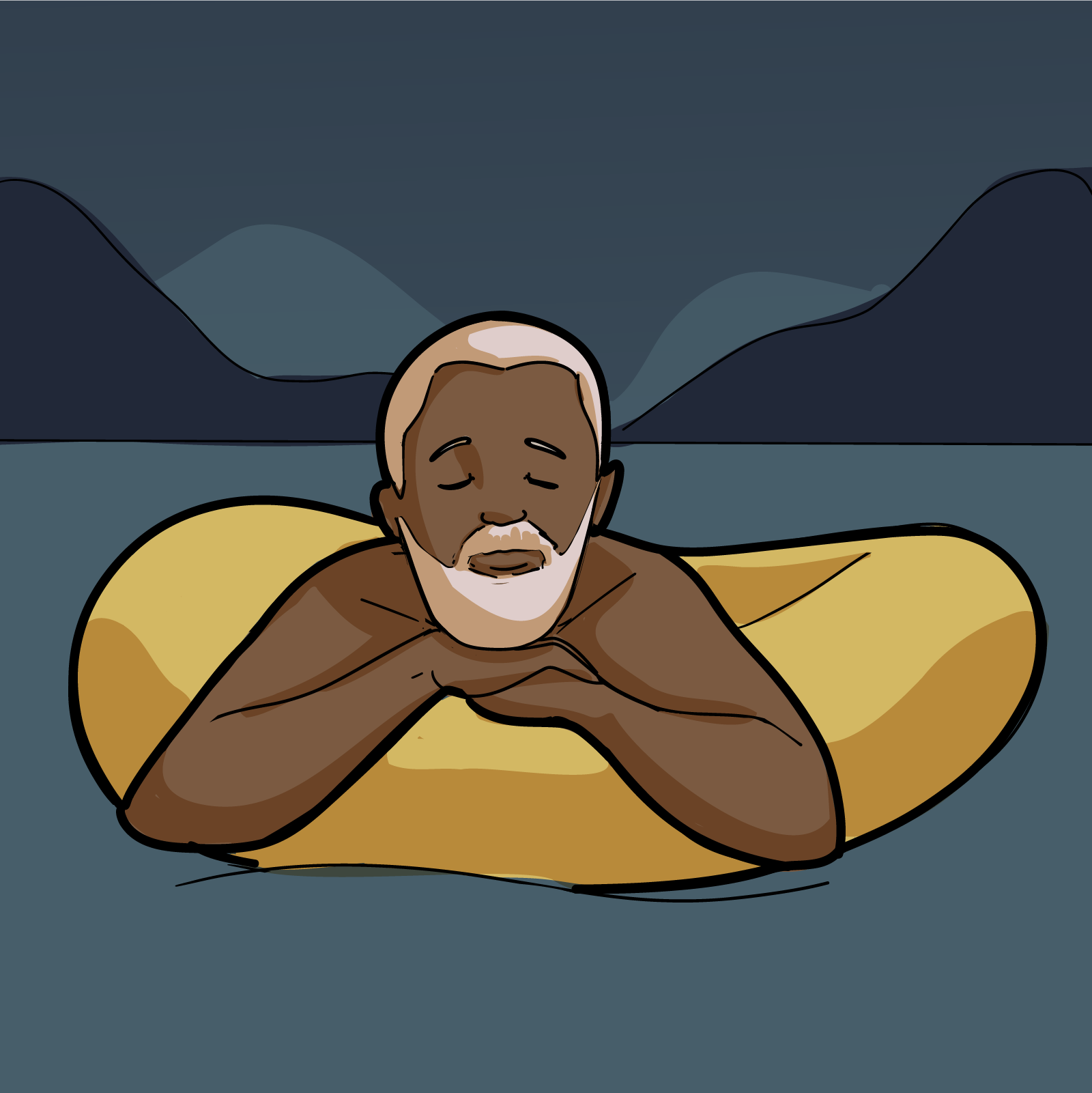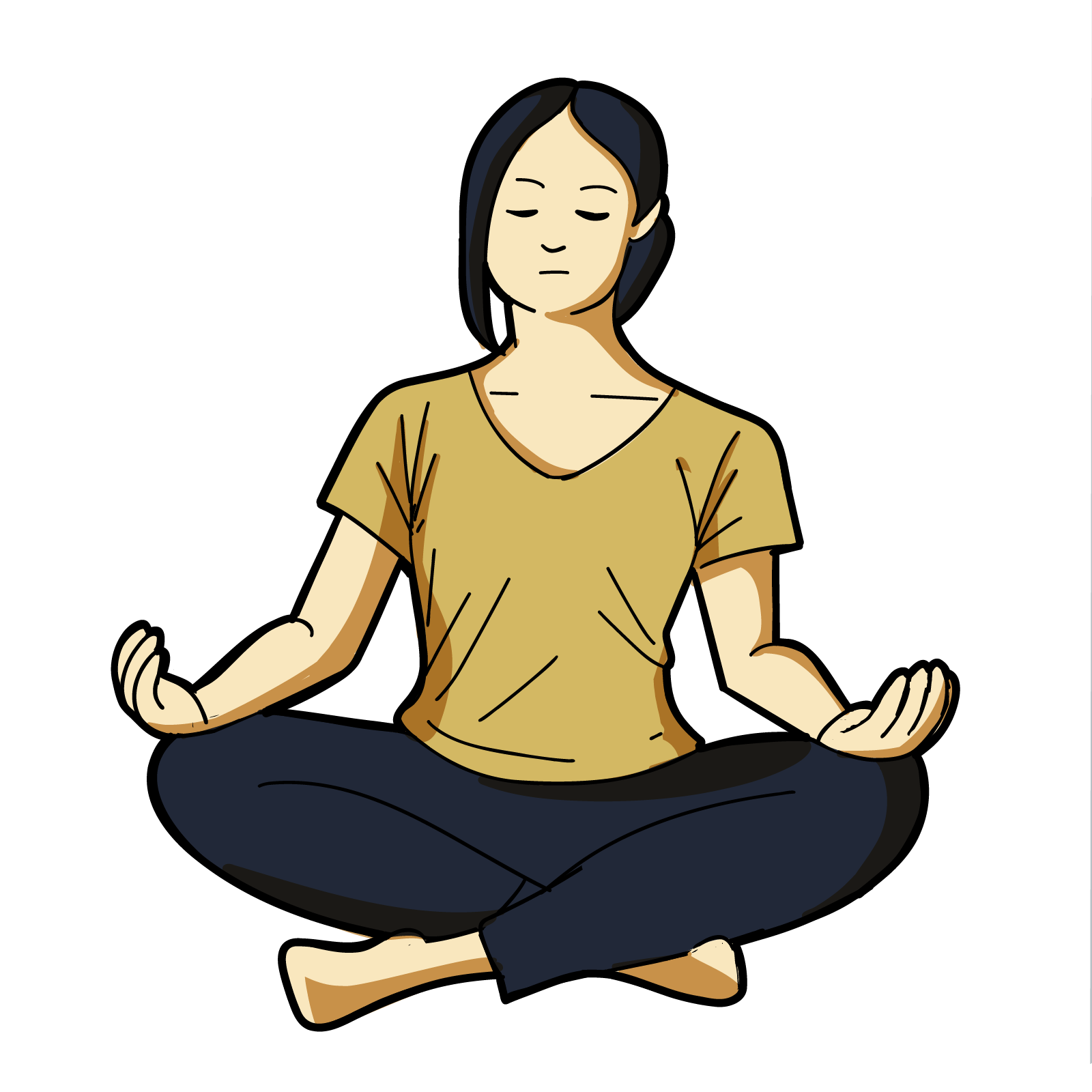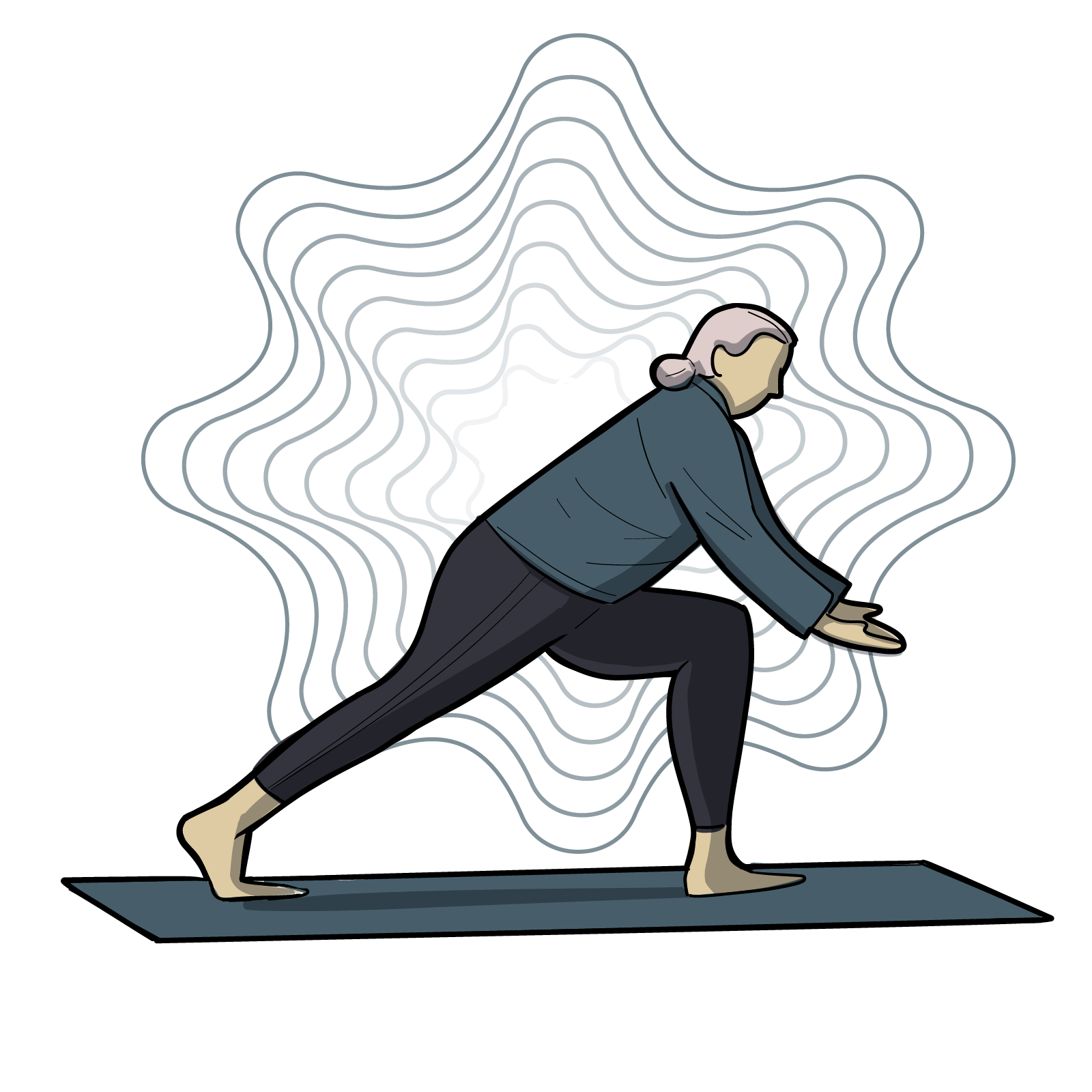Chapter 17. Well-being
Regulation of Stress
Jessica Motherwell McFarlane
Approximate reading time: 43 minutes
As we learned in the previous section, stress — especially if it is chronic — takes a toll on our bodies and can have enormously negative health implications. When we experience events in our lives that we appraise as stressful, it is essential that we use effective coping strategies to manage our stress. Coping refers to mental and behavioural efforts that we use to deal with problems relating to stress.
Coping Styles
Coping strategies are essential tools for managing the stressors in our lives, which Lazarus and Folkman (1984) categorise into two main types: problem-focused and emotion-focused coping. Problem-focused coping involves directly addressing the cause of stress through practical solutions and actions, akin to strategic problem-solving aimed at the external factors of a stressor. For instance, someone facing job dissatisfaction might seek new employment opportunities or pursue further education to enhance their career prospects, actively changing their situation to alleviate stress.
Recent research underscores the effectiveness of these coping mechanisms, highlighting that while problem-focused coping is ideal for controllable stressors, emotion-focused coping is crucial for navigating situations beyond our control (Greenglass & Fiksenbaum, 2009; Compas et al., 2017; El-Monshed et al., 2021). Understanding and applying the appropriate coping strategy can significantly impact our psychological well-being, enabling us to manage stress more effectively and maintain our mental health in the face of life’s challenges.
For example, let’s consider Alex, who is dealing with the stress of a recent breakup. If Alex adopts a problem-focused coping approach, they would take proactive steps to directly address the issues contributing to their stress. This might include seeking out a therapist or counsellor to work through the emotional aspects of the breakup, actively engaging in social activities to rebuild their support network, or even exploring new hobbies and interests to fill the void left by the relationship. Alex might also set specific goals for personal growth and development, such as improving their physical health or advancing their career, to focus on positive change. In doing so, Alex is directly addressing the source of their stress by taking concrete steps to improve their situation and emotional well-being.

Emotion-focused coping, on the other hand, targets the internal emotional response to stress, employing strategies like mindfulness, journaling, or seeking social support to mitigate negative feelings without altering the external stressor. This approach is particularly beneficial when dealing with uncontrollable stressors, where adjusting one’s emotional reaction can provide relief and foster resilience.
For example, let’s revisit Alex, who is dealing with the stress of a recent breakup. Instead of trying to change the situation, Alex engages in emotion-focused coping by practicing mindfulness and meditation to manage their emotional turmoil. They also spend time journaling to express and process their feelings, and engage in self-compassion exercises to nurture a kinder internal dialogue. By doing so, Alex is not trying to alter the reality of the breakup, but rather changing their emotional response to it, helping to reduce the intensity of their distress and gain a sense of peace.
Latest Research
Recent studies have expanded our understanding of coping strategies:
- Proactive coping, involving goal setting and social support, has been associated with better psychological functioning (Greenglass & Fiksenbaum, 2009).
- Maladaptive coping strategies, such as emotional suppression, avoidance, and denial, are linked to higher levels of psychopathology symptoms (Compas et al., 2017). During the COVID19 pandemic, university students’ coping strategies revealed that dysfunctional methods like venting, denial, and substance use scored low on effectiveness, while problem-focused strategies like planning and active coping scored high (El-Monshed et al., 2021).
While many stressors elicit both kinds of coping strategies, problem-focused coping is more likely to occur when encountering stressors we perceive as controllable, and emotion-focused coping is more likely to predominate when faced with stressors that we believe we are powerless to change (Folkman & Lazarus, 1980). Clearly, emotion-focused coping is more effective in dealing with uncontrollable stressors. For example, the stress you experience when a loved one dies can be overwhelming. You are simply powerless to change the situation as there is nothing you can do to bring this person back. The most helpful coping response is emotion-focused coping aimed at minimising the pain of the grieving period.
Fortunately, many stressors we encounter can be modified and are, to varying degrees, controllable. A person who cannot stand their job can quit and look for work elsewhere; a middle-aged divorced person can find another potential partner; the student who fails an exam can study harder next time, and a breast lump does not necessarily mean that one is fated to die of breast cancer.
Control and Stress
The desire and ability to predict events, make decisions, and affect outcomes — that is, to enact control in our lives — is a basic tenet of human behaviour (Everly & Lating, 2002).
Our response to things that might stress us out largely depends on how much control we think we have over them. Perceived control means how much we believe we can influence and change outcomes. This belief is really important for our health and happiness (Infurna & Gerstorf, 2014). A lot of research shows that feeling like we have personal control is linked to many good things, like better physical and mental health, and overall happiness (Diehl & Hay, 2010). Also, when we feel more in control, we tend to get less stressed out by daily problems. For instance, one study found that people who felt more in control at one time were less upset emotionally and physically by problems with other people later on (Neupert, Almeida, & Charles, 2007). Another study, which looked at 34 older women who had lost their husbands, found that on days when these women felt more in control, their stress and anxiety were much lower (Ong, Bergeman, & Bisconti, 2005).
Learned Helplessness
When we feel we can’t control events in our lives, especially harmful or threatening ones, the impact on our minds can be significant. Psychologist Martin Seligman’s experiments in the 1960s are a key example of this (Seligman & Maier, 1967). In these experiments, dogs placed in a chamber and exposed to electric shocks they couldn’t escape later didn’t try to escape even when they could. They seemed to just give up, accepting the shocks. In contrast, dogs that had a chance to escape the shocks in earlier tests did try to escape later on.
Seligman believed that the dogs who failed to try to escape the later shocks were demonstrating learned helplessness; they had acquired a belief that they were powerless to do anything about the stimulation they were receiving. Seligman also believed that the passivity and lack of initiative these dogs demonstrated was similar to that observed in human depression. Therefore, Seligman speculated that learned helplessness might be an important cause of depression in humans; humans who experience negative life events that they believe they are unable to control may become helpless. As a result, they give up trying to change the situation and some may become depressed and show lack of initiative in future situations in which they can control the outcomes (Seligman, Maier, & Geer, 1968).
Seligman and colleagues later reformulated the original learned helplessness model of depression (Abramson, Seligman, & Teasdale, 1978). In their reformulation, they emphasised attributions, which are mental explanations for why something occurred, that fostered a sense of learned helplessness. For example, suppose a coworker shows up late to work; your belief as to what caused the coworker’s tardiness would be an attribution (e.g., too much traffic, slept too late, or just doesn’t care about being on time).
Watch this video: Learned Helpessness: How You’re Unconciously Destroying Your Life (6 minutes)
“Learned Helpessness: How You’re Unconciously Destroying Your Life” video by Project Better Self is licensed under the Standard YouTube licence.
Learned Optimism
Building on this, Seligman (1990) introduced the concept of learned optimism, which counters the detrimental effects of learned helplessness. Learned Optimism is based on the idea that our explanatory style — how we explain life events to ourselves — profoundly affects our mental health and resilience. Seligman identified three critical dimensions of this explanatory style, known as the “Three P’s”: Permanence, Pervasiveness, and Personalization.
- Permanence: This refers to whether an individual perceives the causes of events as stable (permanent) or unstable (temporary). In the context of learned helplessness, a person might view negative events as permanent, leading to a sense of enduring defeat. Conversely, learned optimism encourages seeing bad events as temporary setbacks, fostering resilience and a quicker recovery from challenges.
- Pervasiveness: This dimension involves whether an individual generalises the causes of events. A person with a pessimistic explanatory style might believe that a failure in one aspect of life (like being late) reflects a failure in all aspects, leading to a sense of global defeat. On the other hand, learned optimism involves compartmentalising failures, recognising that a setback in one area does not have to impact other areas of life.
- Personalisation: This pertains to whether individuals attribute events to internal or external causes. In learned helplessness, people might internalise blame for negative events (believing it’s their own fault), leading to lower self-esteem and depression. Learned optimism, however, encourages attributing negative events to external factors and recognising personal agency in positive achievements.
Incorporating these three dimensions into our explanatory style can significantly impact how we cope with life’s challenges. By adopting a more optimistic explanatory style, individuals can foster resilience, improve mental health, and reduce the likelihood of falling into patterns of learned helplessness. This shift in perspective is not just about being positive but about adopting a more realistic and nuanced view of life’s ups and downs.
How We Explain Negative Events to Ourselves
How we explain negative life events to ourselves contributes to depression. Let’s break this down using an example:
Scenario: A student performs poorly on a midterm exam.
Attributions: The model suggests the student will make three kinds of attributions for this outcome:
- Permanence – Stable versus Unstable:
- Stable: Believing the cause is permanent and unchangeable (“Nothing can be done to change the fact that I’m not smart”).
- Unstable: Thinking the cause can be changed.
- Pervasiveness – Global versus Specific:
- Global: Believing the poor performance indicates a general inadequacy (“This is another example of how lousy I am at everything”).
- Specific: Thinking it’s limited to just this area.
- Personalization – Internal versus External:
- Internal: Believing the poor performance was due to personal inadequacies (“I’m just not smart”).
- External: Attributing it to environmental factors.
Impact of Attributions: If the student makes internal, stable, and global attributions for their poor performance, the theory predicts:
- They would perceive a lack of control over this stressful event.
- They would be especially prone to developing depression.
Research Findings: Studies have shown that people who tend to make internal, global, and stable attributions for bad outcomes often develop symptoms of depression when faced with negative life experiences (Peterson & Seligman, 1984).
Positive Aspect: Attribution habits can be changed through practice. Training in healthy attribution habits has been shown to reduce vulnerability to depression (Konnikova, 2015).
Seligman’s theory about attributions and depression has received significant supporting evidence. Research has consistently shown that perceptions of control over one’s life have significant implications for physical health. For instance, people who feel they have more control over their lives tend to see their physician as something they can actively manage, which is linked to better health management and positive health behaviours (Bandura, 2004).
Moreover, a greater sense of perceived control is associated with a reduced risk of various health problems, including decreased physical decline (Infurna et al., 2011), lower incidence of heart attacks (Rosengren et al., 2004), and heart disease (Stürmer, Hasselbach, & Amelang, 2006; Surtees et al., 2010). Additionally, the work environment plays a crucial role in this dynamic. Individuals in lower-status jobs with minimal control over their work are at a higher risk of developing heart disease compared to those in higher-status jobs with more control (Marmot et al., 1997). This body of research underscores the profound impact of psychological factors, particularly perceived control, on physical health outcomes.
Social Support
The need to form and maintain strong, stable relationships with others is a powerful, pervasive, and fundamental human motive (Baumeister & Leary, 1995). Social support, which can be thought of as the soothing impact of friends, family, and acquaintances (Baron & Kerr, 2003), plays a crucial role in our well-being. It refers to the emotional, informational, and practical help we receive from our social network. This support can take many forms, including advice, guidance, encouragement, acceptance, emotional comfort, and tangible assistance such as financial help. The presence of a supportive social circle is comforting when we face a range of life stressors and is instrumental in managing these challenges.
Lack of Social Support: Health Declines
The importance of social support first emerged in the 1970s when health researchers developed an interest in the health consequences of social connectedness — being connected and engaged within their social networks, including family, friends, colleagues, and community groups (Stroebe & Stroebe, 1996). This interest was further fueled by longitudinal studies showing that social connectedness reduced mortality. For instance, a classic study followed nearly 7,000 Alameda County, California, residents over 9 years. Those who lacked social and community ties were more likely to die during the follow-up period than those with more extensive social networks. Isolated men and women were, respectively, 2.3 and 2.8 times more likely to die compared to those with the most social contacts. These trends persisted even after controlling for health-related variables like smoking, alcohol consumption, self-reported health at the beginning of the study, and physical activity (Berkman & Syme, 1979).
Since that study, social support has been recognised as one of the well-documented psychosocial factors affecting health outcomes (Uchino, 2009). A statistical review of 148 studies conducted between 1982 and 2007 involving over 300,000 participants concluded that individuals with stronger social relationships have a 50% greater likelihood of survival compared to those with weak or insufficient social relationships (Holt-Lunstad, Smith, & Layton, 2010). The magnitude of the effect of social support observed in this study is comparable with quitting smoking and exceeds many well-known risk factors for mortality, such as obesity and physical inactivity.

A number of large-scale studies have found that individuals with low levels of social support are at greater risk of mortality, especially from cardiovascular disorders (Brummett et al., 2001). Higher levels of social support have been linked to better survival rates following breast cancer (Falagas et al., 2007) and infectious diseases, especially HIV infection (Lee & Rotheram-Borus, 2001). In fact, a person with high levels of social support is less likely to contract a common cold. In one study, 334 participants completed questionnaires assessing their sociability; these individuals were subsequently exposed to a virus that causes a common cold and monitored for several weeks to see who became ill. Results showed that increased sociability was linearly associated with a decreased probability of developing a cold (Cohen, Doyle, Turner, Alper, & Skoner, 2003).
For many of us, friends are a vital source of social support. But what if you find yourself in a situation in which you have few friends and companions? Many students who leave home to attend and live at college experience drastic reductions in their social support, which makes them vulnerable to anxiety, depression, and loneliness. Social media can sometimes be useful in navigating these transitions (Raney & Troop Gordon, 2012) but might also cause increases in loneliness (Hunt, Marx, Lipson, & Young, 2018). For this reason, many colleges have designed first-year programs, such as peer mentoring (Raymond & Shepard, 2018), that can help students build new social networks. For some people, our families — especially our parents — are a major source of social support.

Social support appears to work by boosting the immune system, especially among people who are experiencing stress (Uchino, Vaughn, Carlisle, & Birmingham, 2012). In a pioneering study, spouses of cancer patients who reported high levels of social support showed indications of better immune functioning on two out of three immune functioning measures, compared to spouses who were below the median on reported social support (Baron, Cutrona, Hicklin, Russell, & Lubaroff, 1990). Studies of other populations have produced similar results, including those of spousal caregivers of dementia sufferers, medical students, elderly adults, and cancer patients (Cohen & Herbert, 1996; Kiecolt-Glaser, McGuire, Robles, & Glaser, 2002).
In addition, social support has been shown to reduce blood pressure for people performing stressful tasks, such as giving a speech or performing mental arithmetic (Lepore, 1998). In these kinds of studies, participants are usually asked to perform a stressful task either alone, with a stranger present (who may be either supportive or unsupportive), or with a friend present. Those tested with a friend present generally exhibit lower blood pressure than those tested alone or with a stranger (Fontana, Diegnan, Villeneuve, & Lepore, 1999). In one study, 112 female participants who performed stressful mental arithmetic exhibited lower blood pressure when they received support from a friend rather than a stranger, but only if the friend was a male (Phillips, Gallagher, & Carroll, 2009). Although these findings are somewhat difficult to interpret, the authors mention that it is possible that females feel less supported and more evaluated by other females, particularly females whose opinions they value.
Taken together, the findings above suggest one of the reasons social support is connected to favourable health outcomes is because it has several beneficial physiological effects in stressful situations. It is also important, however, to consider the possibility that social support may lead to better health behaviours, such as a healthy diet, exercise, smoking cessation, and cooperation with medical regimens (Uchino, 2009).
Stress Reduction Techniques
In managing stress, beyond establishing social support networks and having a sense of control, various techniques have proven effective. These include exercise, nature-based relaxation methods like forest therapy and nature walks, Mindfulness-Based Stress Reduction (MBSR), and biofeedback. Each of these approaches offers unique benefits in combating stress.
Exercise is a widely recognised method for stress reduction, offering both physical and mental health benefits (Salmon, 2001). Complementing this, nature-based relaxation methods such as forest bathing and nature walks have gained attention for their ability to improve mood and overall well-being. MBSR, developed by Dr. Jon Kabat-Zinn, combines mindfulness meditation, body awareness, and yoga, providing a structured approach to stress management. Additionally, biofeedback techniques, which involve monitoring and controlling physiological processes, offer another avenue for managing stress effectively.
Exercise for Stress Reduction
Exercise is frequently prescribed for stress reduction. It is well established that exercise, both of long (aerobic) and short (anaerobic) duration, is beneficial for both physical and mental health (Everly & Lating, 2002). Physically fit individuals are more resistant to the adverse effects of stress and recover more quickly from stress than less physically fit individuals (Cotton, 1990). In a study of more than 500 Swiss police officers and emergency service personnel, increased physical fitness was associated with reduced stress, and regular exercise was reported to protect against stress-related health problems (Gerber, Kellman, Hartman, & Pühse, 2010).
Telomeres are like the protective caps at the ends of our shoelaces, but for our chromosomes, which carry our DNA. Just as those caps prevent the shoelaces from fraying, telomeres protect our chromosomes from damage. Over time, as cells divide, telomeres get shorter, and when they become too short, the cell can no longer divide and will die. This process is connected to ageing and health issues.
Telomerase is a special enzyme that can add length back to telomeres, helping cells live longer. However, our body’s use of telomerase is limited, so telomeres still tend to get shorter as we age.
Stress plays a role in this process because it can speed up the shortening of telomeres. This means that being under a lot of stress might make our cells age faster, which could make us look and feel older than we are.
Exercise comes into the picture as a superhero for our telomeres. Regular physical activity has been shown to help keep telomeres from shortening too quickly. This doesn’t just help us look younger; it’s also about keeping our cells and bodies healthier for longer. Exercise helps manage stress, which in turn protects our telomeres from the damaging effects of stress. This is one of the many reasons why exercise is recommended for maintaining good mental and physical health.
Exercise may be beneficial because it helps counteract the harmful physical effects of stress. It has been found to significantly reduce anxiety in people with anxiety or stress-related disorders, making it a valuable treatment option (Stubbs et al., 2017). For mental health professionals, exercise programs have been effective in reducing work-related stress (Fibbins et al., 2018). In people experiencing high levels of stress, regular exercise can prevent the shortening of telomeres, which are parts of our chromosomes. This prevention might contribute to the youthful appearance often seen in those who exercise regularly (Puterman et al., 2010). Additionally, exercising in later life can lessen the negative impact of stress on the hippocampus, an area of the brain important for memory (Head, Singh, & Bugg, 2012). For cancer survivors, exercise has been shown to reduce both anxiety (Speck, Courneya, Masse, Duval, & Schmitz, 2010) and symptoms of depression (Craft, VanIterson, Helenowski, Rademaker, & Courneya, 2012). Overall, exercise is a highly effective way to manage stress.
Forest Bathing and Being in Nature
The term often used for therapy in nature is “Forest Bathing,” also known as “Shinrin-yoku” in Japanese. This practice involves immersing oneself in the forest atmosphere, and it’s a form of nature therapy that has gained popularity for its mental and physical health benefits. The concept is rooted in the idea that spending time in nature, particularly forests, can reduce stress, improve mood, and enhance overall well-being.
Forest therapy, including activities such as nature walks, has been recognised for its positive impact on mental health. A study by Ochiai et al. (2015) found that forest therapy significantly reduces blood pressure and improves mood, particularly in middle-aged males with high-normal blood pressure. This suggests that spending time in forest environments can be a powerful tool for stress management.
The combination of physical activity with relaxation in natural settings offers another effective approach to stress reduction. Matzer et al. (2018) conducted a study demonstrating that combining walking and relaxation in natural environments, such as parks or forests, effectively reduces systolic blood pressure and promotes relaxation. This indicates that engaging in physical activities in nature can enhance the stress-reducing effects of both exercise and natural surroundings.
Furthermore, integrating mindfulness practices with exposure to natural environments can amplify well-being outcomes. Choe, Jorgensen, and Sheffield (2020) found that mindfulness practices, when combined with exposure to natural environments, improve well-being outcomes and enhance nature connectedness. This research suggests a synergistic effect between mindfulness activities and nature-based experiences, offering a holistic approach to stress management.

In conclusion, nature-based relaxation techniques, including forest therapy, nature walks, swimming in the ocean and the integration of other physical activity with nature, provide effective means for reducing stress. These methods not only offer psychological benefits but also contribute to physical health, highlighting the importance of nature in promoting overall well-being.
Indigenous Wellness Practices: A Unique Cultural Perspective
In addition to the individualistic and collectivistic perspectives, it’s essential to consider the unique approaches of Indigenous cultures, such as those of the Coast Salish people, towards happiness and stress. Indigenous wellness practices offer a deep, spiritual connection to nature and community, emphasising holistic well-being.
- Sweat Lodge Ceremonies: The Coast Salish people practice sweat lodge ceremonies, which are spiritual events used for purification and healing. Participants enter a dome-shaped lodge where they experience ceremonial steam baths, symbolising rebirth and connection to Mother Earth.
- Sage Smudging: Sage smudging involves burning sage to cleanse a person or space of negative energies. This practice is used for purification, emotional and spiritual healing, and is deeply rooted in the spiritual traditions of the Coast Salish.
- Cedar Brushing: Cedar brushing is another cleansing ritual that uses the sacred cedar tree. It involves using cedar boughs to brush over the body, believed to cleanse and protect the individual spiritually.

These practices reflect a profound understanding of happiness and stress that is intrinsically linked to the natural world and communal living. They emphasise the importance of spiritual balance, community support, and a harmonious relationship with nature.
The inclusion of Indigenous wellness practices in psychological research on happiness and stress underscores the importance of a diverse cultural lens. It highlights how different cultures utilise unique practices and beliefs to manage well-being. Understanding these practices enriches our perspective and allows for a more comprehensive approach to psychological health that respects and incorporates the wisdom of various cultural traditions.
Mindfulness-Based Stress Reduction

Mindfulness-Based Stress Reduction (MBSR) is a structured program designed to help individuals manage stress through mindfulness practices. It was developed by Dr. Jon Kabat-Zinn in the late 1970s and has since been widely adopted in various settings, including healthcare, education, and corporate environments. MBSR combines mindfulness meditation, body awareness, and yoga to help people become more mindful.
Step-by-Step Guide to Mindfulness Meditation (Kabat-Zinn, 1994)
- Find a Quiet Space: Choose a quiet and comfortable place where you won’t be disturbed. This could be a quiet room, a peaceful corner, or even a spot in a park.
- Set a Time Limit: If you’re just beginning, it might be helpful to choose a short time, such as 5 or 10 minutes.
- Adopt a Comfortable Posture: You can sit on a chair with your feet flat on the ground, sit cross-legged on the floor, or lie down. The key is to maintain a posture that is comfortable yet alert.
- Close Your Eyes: Gently close your eyes. This helps to reduce visual distractions and focus inward.
- Focus on Your Breath: Pay attention to the sensation of your breath as it enters and leaves your nostrils, or the rise and fall of your chest or abdomen. You don’t need to control the breath, just observe it.
- Notice When Your Mind Wanders: It’s natural for your mind to wander. When you notice this happening, acknowledge it and gently redirect your attention back to your breath.
- Be Kind to Your Wandering Mind: Don’t judge yourself or obsess over the content of the thoughts you find yourself lost in. Just come back to your breath.
- End the Session Gently: When your time is up, open your eyes. Take a moment to notice any sounds in the environment. Notice how your body feels right now. Notice your thoughts and emotions.
- Practice Regularly: Consistency is key. Try to practice mindfulness meditation daily, even if it’s just for a few minutes.
Tips for Mindfulness Meditation: It’s normal to find meditation challenging at first. The practice is about returning your attention to your breath every time you get lost in thought. You might find it helpful to silently label the thoughts as “thinking” before returning to your breath. Some people find it helpful to attend a guided meditation session or use a meditation app when starting out.
Research on Mindfulness-Based Stress Reduction (MBSR) has demonstrated its effectiveness in various contexts. MBSR training can reduce emotional reactivity and enhance emotion regulation in patients with social anxiety disorder, potentially improving their anxiety, depression, and self-esteem (Goldin and Gross, 2010). In high-stress professional environments, MBSR has been shown to effectively increase positive coping strategies and decrease negative ones (Walach et al., 2007). MBSR is moderately effective in reducing stress, depression, anxiety, and distress, while also improving the quality of life in healthy individuals (Chang et al., 2004; Khoury et al., 2015; Zhu et al., 2019). These studies collectively highlight the broad applicability and effectiveness of MBSR in enhancing mental health and coping strategies across different populations.
The relaxation response approach is conceptualised as a general approach to stress reduction that reduces sympathetic arousal, and it has been used effectively to treat people with high blood pressure (Benson & Proctor, 1994).

Yoga intervention is better than fitness exercises in helping undergraduates cultivate mindfulness and reduce stress (Tong et al., 2020). Regular practice of yogasanas improved glycemic (sugar) control, oxidative (oxygen) stress markers, inflammatory markers, and sleep quality among subjects with type 2 diabetes (Viswanathan et al., 2020).
Summary
This section focuses on understanding how we can manage and reduce stress through various strategies and support systems. It starts with an exploration of different coping styles, highlighting how individuals respond to stress in diverse ways and the effectiveness of these methods. The section then delves into the concepts of control and stress, discussing how feelings of control can mitigate stress effects, while learned helplessness can deepen the impact of stress on our lives. A video on learned helplessness provides further insight into this phenomenon, contrasting it with learned optimism, which is illustrated through Whitney’s case study on overcoming alcohol addiction with a positive mindset.
Social support is emphasised as a crucial factor in stress regulation, with discussions on how strong social networks can boost our immune system and how a lack of support can lead to health declines. The narrative then transitions into stress reduction techniques, covering a range of practices from exercise and forest bathing to indigenous wellness practices and mindfulness-based stress reduction (MBSR). Each technique is presented as a tool for managing stress, with mindfulness practices detailed through a step-by-step guide to mindfulness meditation.
Chapter Conclusion
This chapter has taken a close look at how happiness, stress, and health are connected and how they affect our lives. We started by looking at what makes us happy, including the role of positive thinking and being grateful. We learned that doing things we enjoy and are good at can lead to deep satisfaction.
Then, we talked about stress, showing that it can be both good and bad for us. We saw how stress works in our bodies and minds and how it can lead to health problems if it’s not managed well. We also discussed ways to handle stress better, like mindfulness and getting support from friends and family. We also looked at how our surroundings and life experiences, like tough childhoods or lack of support, can impact our health and happiness.
In the end, this chapter showed that being well means more than just not being sick. It’s about feeling good emotionally, mentally, and socially. It’s important to look at the whole picture, including our feelings, relationships, and where we live and work.
To sum up, we’ve learned important lessons about how to live a happier, healthier life by increasing uplifts and glimmers, managing stress and our responses to hassles and triggers, finding joy in what we do, and supporting each other. These lessons are useful for everyone, including psychologists who help others. By keeping these ideas in mind, we can all work toward a life that’s not just about getting through each day, but really living well.
My Story, Part 2: Embracing Well-being in the Midst of Lockdown … Continued
As we reach the end of this chapter, I will return to my opening story of seeking well-being amidst the uncertainty of lockdown. The principles and strategies we’ve explored here in this chapter are not just academic concepts; they are the tools that supported me through those challenging lockdown times. If you are inspired to delve deeper, I encourage you to consider enrolling in Dr. Laurie Santos’s’ “The Science of Well-Being” course, available online for free. It’s an opportunity to expand your understanding of well-being and continue applying these principles in your own life.
Alternatively, you might find value in forming a group around another course or activity that resonates with you. Remember, the power of social support, as I experienced with my study group, can be a significant factor in enhancing your learning and well-being. Whether it’s through formal study, a thrilling role-play game, or other informal gatherings, the key is to connect, share, and grow together. As we close this chapter, I invite you to carry forward the spirit of learning and well-being into your own lives, creating your own stories of overcoming challenge and growing your resilience. By seeking support from compassionate others and directing your energy and attention to health-promoting actions, you can play a powerful role in creating and maintaining your well-being.
Image Attributions
Figure WB.17. Photo by Brad Neathery on Unsplash.
Figure WB.18. Photo by Kimson Doan on Unsplash.
Figure WB.19. Photo by Helena Lopes on Unsplash.
Figure WB.20. Being in nature by Rachel Lu is licensed under a CC BY-NC-SA license.
Figure WB.21. Photo by Adam Kring on Unsplash.
Figure WB.22. MBSR by Rachel Lu is licensed under a CC BY-NC-SA license.
Figure WB.23. Yoga by Rachel Lu is licensed under a CC BY-NC-SA license.
To calculate this time, we used a reading speed of 150 words per minute and then added extra time to account for images and videos. This is just to give you a rough idea of the length of the chapter section. How long it will take you to engage with this chapter will vary greatly depending on all sorts of things (the complexity of the content, your ability to focus, etc).

